Temple Of Literature In Vietnam Venerating Scholars
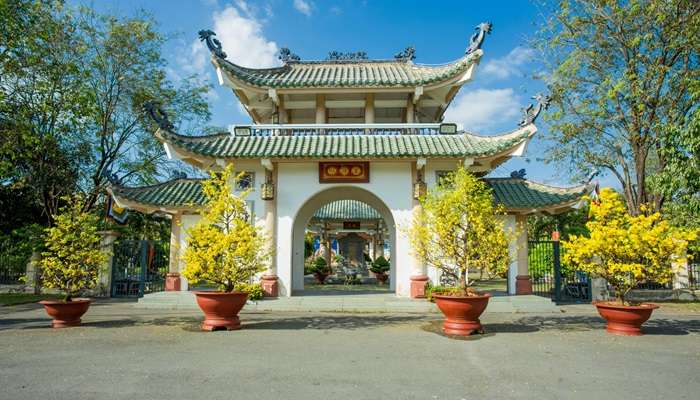
Built-in 1070 during the reign of Emperor Ly Thanh Tong, the Temple of Literature in Vietnam is a sanctuary of education and an international symbol of Hanoi. The Temple of Literature in Hanoi, Vietnam, is also called Van Mieu. Initially, the venue served as a school wherein the emperor, crown prince, and court officials were educated. The Temple of Literature in Vietnam is also a sanctuary of Confucius, honouring outstanding scholars and recognising great educational contributions. Teeming with history, the Temple of Literature in Hanoi symbolises Vietnam’s rich past, present, and future.
Cultural And Educational Significance Of The Temple
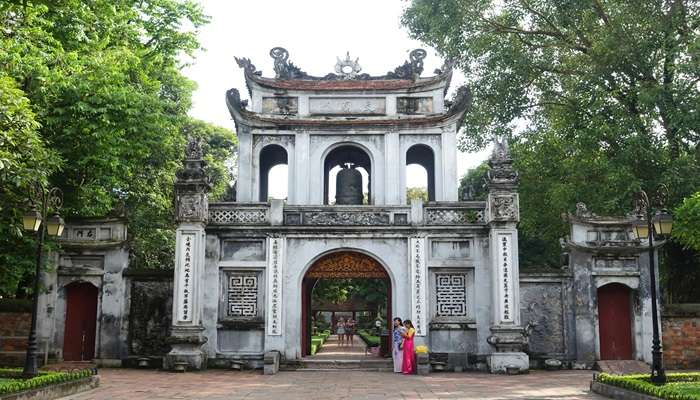
In Vietnamese historical tradition, the Temple of Literature has significant cultural meaning. The Temple of Literature in Hanoi, with its various unique structures and spaces, is one of the most important works of ancient Vietnamese architecture. It is a rare case of a complex of historical, architectural and scenic sites that cannot be compared with any similar work in Vietnam.
It is the place to conduct research and consultancy for UNESCO and the world to investigate and study the famous literature in Vietnam. The temple of the famous literature in Vietnam is inscribed on the list of UNESCO Cultural Documentary Heritage. For a culture vulture this place is a heaven on earth.
Tip: Photography is permitted, but do not use flash in areas that may be sensitive and keep in mind other people trying to visit the place.
Must Read: Heritage Sites In Vietnam
Five Elements Theory
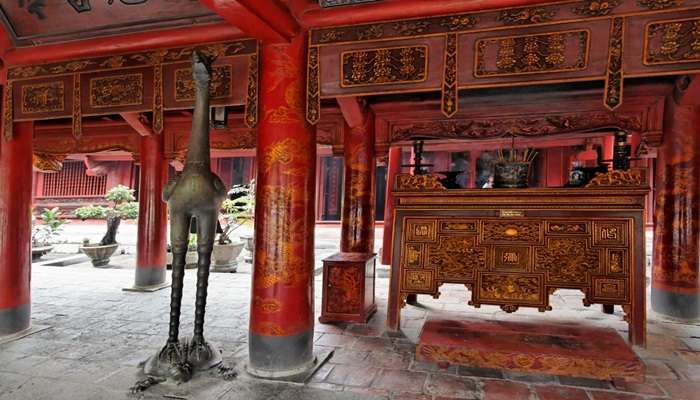
In the belief of human beings, the Five Elements (Wood, Fire, Earth, Metal and Water) are the elements from which all things in the world were created and are closely related. The relations of the Five Elements are explained by the five different actions of Metal (killing, cooperating, controlling, destructing, giving birth), married to produce all things.
The Temple of Literature in Vietnam is an example that also follows that theory, as it was an important architectural site of feudal capital. It is a place of the most sacred space that the kings made for Confucius and his vestiges. It contains all the classic Vietnamese literature.
The Five Courtyards
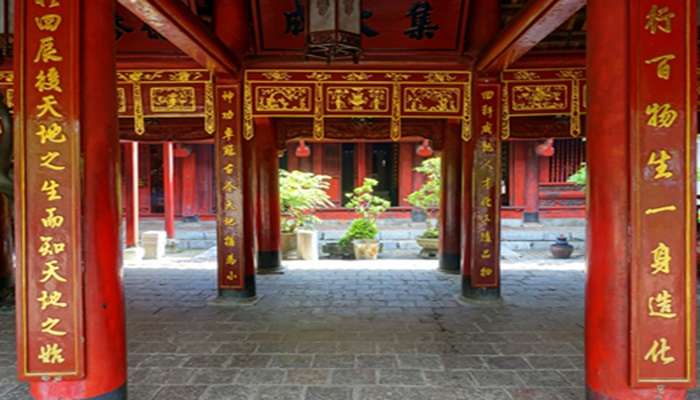
The Temple of Literature in Vietnam is a temple of Confucius, and thus a temple of Confucianism. This is widely considered to be Vietnam’s first national university. The temple was first constructed in 1070, and it provides a very interesting look at what the training of scholars looked like during this period. The entire complex is rather large, and broken up into five separate courtyards.
- First Courtyard: The Gate of Great Synthesis
- Second Courtyard: The Gate of Great Success
- Third Courtyard: The Gate of Great Purity
- Fourth Courtyard: The Gate of Great Light
- Fifth Courtyard: The Imperial Academy
Suggested Read: Landmarks In Vietnam
How To Reach The Temple And The Best Time To Visit It

The Temple of Literature in Vietnam is typically open to visitors from 8:00 AM to 4:00 PM daily. To ensure you can explore comfortably, you must arrive at least thirty minutes before the temple closes.
- Early Morning: For the sake of avoiding people and to prevent me from feeling hot.
- Late Afternoon: To escape the busy atmosphere and enjoy the cool under the sky.
- Public Holidays: Discover their timings during the nation’s public vacations and particular occasions.
To Reach The Temple of Literature in Vietnam
- Taxi/Ride-Hailing: You can use either the Mai Linh or the Vinasun taxi company, or you can use a ride-hailing service like Grab.
- Public Bus: Go from the type of buses, which can be either 02, 23, or 38. The stop is “Văn Miếu,” which is 50 metres away.
- Bicycle/Motorbike: A rental bike or motorbike will help you have a convenient and flexible trip.
- Walking: It is a 30-minute walk to Hoan Kiem Lake and a 20-minute walk from the train station.
- Tour Services: Join organised tours, which include transport admission.
Guided Tours And Activities
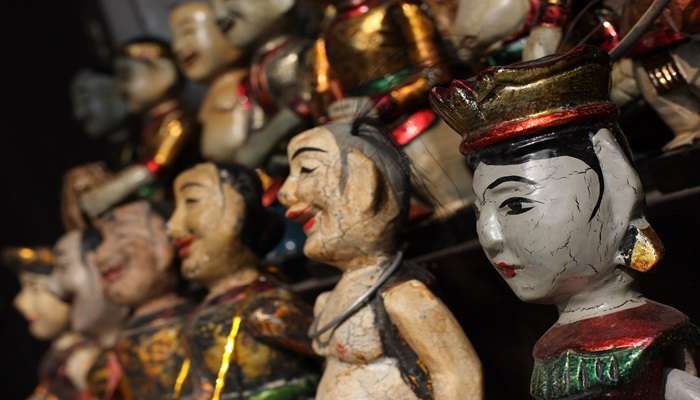
In addition to the cognition of historical value, tourists are invited to engage in community animated programs hosted by local people, scholars, or volunteers to participate in a wide range of activities. The Temple of Literature in Vietnam is well worth an exploration. These programs can be divided into several characters and themes such as school programs, workshops on traditional handicrafts, an animated visit with a varied format, exhibitions, and practising cultural heritage. Various art performances were held, and the International Traditional Guqin Festival was established every two years.
Those who are interested in historical and cultural backgrounds are encouraged to take guided tours to seek the intimate value of the site. The programs are available in diverse languages to provide profound background information. It showcases the famous literature in Vietnam.
Tip: Combine your trip with other destinations in the neighbourhood like the ancient Hoan Kiem Lake or the antique Old Quarter.
Further Read: Places To Visit In Vietnam
The Temple of Literature reflects Vietnam’s great culture and tradition. It shows the unique architecture of the pre-Thang Long period. The Temple of Literature in Vietnam was also the centre for worshipping Confucius. It gradually lost its function but remains a bewildering architecture with the symbolic significance of Buddha in Vietnam. Plan your trip to Vietnam and discover the temple’s deep-rooted history and its meaning in culture.
For our editorial codes of conduct and copyright disclaimer, please click here.
Frequently Asked Questions About Temple of Literature In Vietnam
Which is the temple of literature in Vietnam?
The Confucian Temple, Van Mieu, is a historical and cultural site in Hanoi, Vietnam, honouring the sage and is considered the first university in the country.
When did the Temple of Literature in Vietnam come into being?
In the year 1070, Emperor Ly Thanh Tong constructed the Temple of Literature during his reign.
What is the importance of the Temple of Literature in Hanoi, Vietnam to Vietnamese culture?
The temple has performed a very important function of education and scholarships, thus making a clear picture of the Vietnamese people's respect for learning and wisdom.
What does the 5 Elements Theory relate to the Altar of Literature and what is their impact on today's society?
The Five Elements Theory plays a key role in the design of the temple, suggesting the interconnectedness of all things and the temple’s sacred place devoted to Confucius.
The Five Elements Theory plays a key role in the design of the temple, suggesting the interconnectedness of all things and the temple’s sacred place devoted to Confucius.
The temple is made up of five courtyards, each lined with different details, including the Gate of Great Synthesis, the Gate of Great Success, the Gate of Great Purity, the Gate of Great Light and the Imperial Academy.
People Also Read:
Buddhist Temples In Sri Lanka Temples In Thailand Temples In Auckland

As a Travel Content Writer, I live to conquer the world of globetrotting with words. With my unquenchable thirst for storytelling, I believe that my words will inspire you to travel around the world’s breathtaking landscapes. As for me, I am an unapologetic selenophile, who loves to wander around in a starry night!











